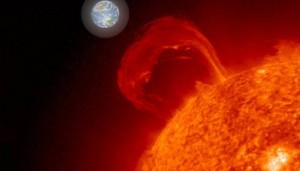Scientists have discovered an “invisible shield” roughly 7,200 miles (11,500 kilometers) above Earth that blocks so-called “killer electrons” – highly charged electrons that can fry satellites, degrade space systems during intense solar storms, and pose serious health risks to astronauts.
Researchers say that an “extremely sharp” boundary at the inner edge of the outer belt at that altitude appears to block the ultrafast electrons from breeching the shield and moving deeper towards Earth’s atmosphere.
“It’s almost like theses electrons are running into a glass wall in space,” said Daniel Baker, director of CU-Boulder’s Laboratory for Atmospheric and Space Physics (LASP).
Baker said the new discovery is somewhat like the shields created by force fields on Star Trek that were used to fend off alien weaponry.
“We are seeing an invisible shield blocking these electrons. It’s an extremely puzzling phenomenon,” Baker added in a Univ. of Colorado, Boulder press statement.
Twin probes
The impenetrable barrier has been observed by the twin Van Allen belt probes launched by NASA in August 2012.
A paper has been published in the Nov. 27 issue of Nature magazine, at: http://www.nature.com
As the study’s lead author, Baker said: “It’s not obvious how the slow, gradual processes that should be involved in motion of these particles can conspire to create such a sharp, persistent boundary at this location in space.”
“I think the key here is to keep observing the region in exquisite detail, which we can do because of the powerful instruments on the Van Allen probes,” Baker said. “If the Sun really blasts the Earth’s magnetosphere with a coronal mass ejection (CME), I suspect it will breach the shield for a period of time.”
Unusual phenomenon
“It’s a very unusual, extraordinary, and pronounced phenomenon,” says John Foster, associate director of MIT’s Haystack Observatory – also an author of the published research paper.
“What this tells us is if you parked a satellite or an orbiting space station with humans just inside this impenetrable barrier, you would expect them to have much longer lifetimes. That’s a good thing to know,” Foster said in an MIT press release.
Additional CU-Boulder study co-authors include Allison Jaynes, Vaughn Hoxie, Xinlin Li, Quintin Schiller, Lauren Blum and David Malaspina.
Other co-authors were from UCLA, The Aerospace Corp. Space Sciences Lab in Los Angeles, the University of Minnesota, NASA’s Goddard Space Flight Center in Greenbelt, Maryland, the University of Iowa and the New Jersey Institute of Technology.
The Van Allen probes mission is part of NASA’s Living with a Star Program managed by the Goddard Space Flight Center. The Johns Hopkins University Applied Physics Laboratory built the twin satellites and is managing the mission for NASA.
By Leonard David

